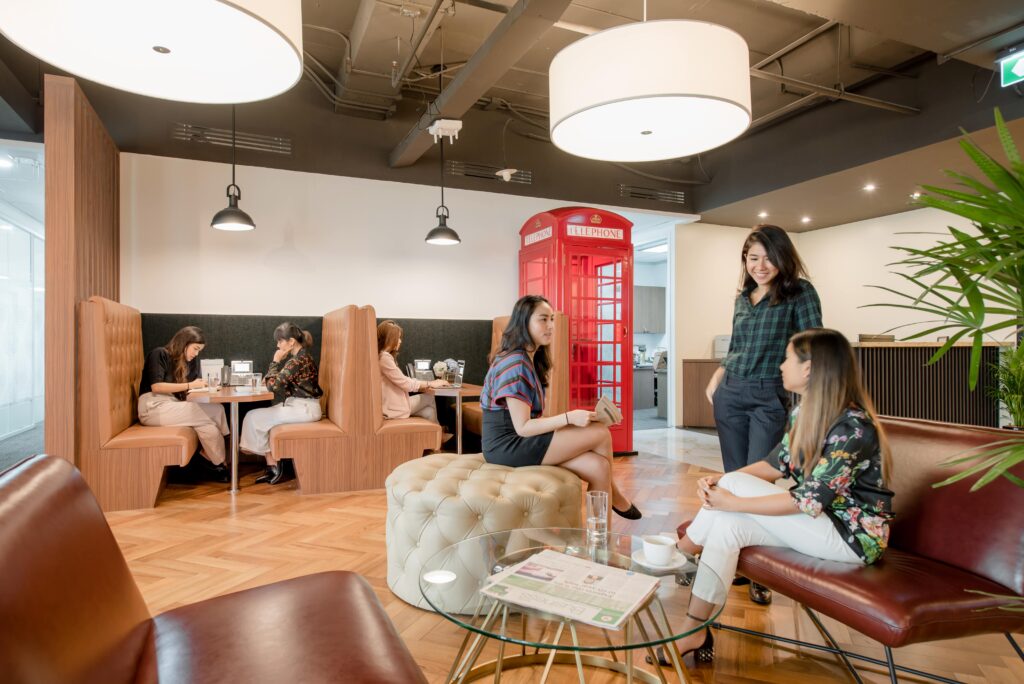Getting things done takes more than a laptop and a task list. Sometimes, what we really need is the right environment – one that energizes us, helps us focus, and keeps us feeling good along the way. If you’ve ever felt unmotivated, disconnected, or mentally tired while working alone, you’re not alone.
Coworking spaces have grown in popularity not just because they’re convenient, but because they support how we actually work. These shared spaces are designed to nurture physical and mental health, boost morale, and help you feel part of something even when you’re working independently.
The field of coworking productivity psychology explores how these environments improve our ability to focus, connect, and perform. With the right layout, culture, and rhythm, coworking becomes a setting where people can thrive personally and professionally.
If done right, the right workspace can positively impact mood, concentration, and overall productivity. Find out how coworking spaces feed into positive emotions and coworking success below!
How Social Support Fuels Employee Engagement
In coworking spaces, you’re rarely alone even when working independently. Just being near others creates subtle support systems. The more you connect with neighboring workers, the more genuine your connections end up being. That in itself reinforces your own behavior.
In one study published in Frontiers in Psychology, researchers found that workers in coworking environments reported greater performance satisfaction. Much of that came from having social anchors. When stress levels rose, these individuals handled pressure better because they didn’t feel isolated.
Support like this doesn’t exist in many traditional office settings, where hierarchy and rigid structures can limit openness. In coworking, support emerges naturally – and that sense of being backed up, even informally, helps professionals bounce back from challenges and stay engaged.
This matters more than ever for remote workers and freelancers who may lack team structures. A supportive setting provides external motivation and psychological cushioning that strengthens day-to-day resilience.
Belonging and Safety Matter More Than You Think
Psychological safety is the ability to speak freely, take creative risks, and ask for help without fear of judgment. Coworking spaces foster this safety by design. There are no corner offices or closed-door politics, making your colleagues much more approachable.
This kind of emotional freedom is hard to find in many traditional office settings, where hierarchy can limit openness. In coworking, the playing field is level. People from different industries and backgrounds share space, exchange ideas, and respect each other’s work.
Motivation Grows in the Right Environment
Social facilitation is a well-known psychological concept that suggests people perform better when others are nearby, even if they’re not interacting directly. Such a phenomenon is obvious in coworking spaces, where they harness this naturally. When you’re surrounded by focused individuals, that presence becomes a gentle push, a type of external motivation that nudges you into flow.
Community feedback from coworking members consistently highlights this dynamic. Many say they feel more driven and committed simply because the environment encourages them to keep pace with others. This motivation doesn’t feel competitive. It feels collaborative, giving you a sense of belonging, and helping you maintain focus especially during long or mentally demanding projects.
Design That Supports Mental Health and Focus
Our surroundings play a huge role in how we think and feel. Poor lighting, loud noise, or cluttered layouts can make it harder to concentrate and keep your energy up. Coworking spaces are built with this in mind. You’ll often find natural light, indoor plants, high ceilings, and calm color palettes, adding to psychological safety from ennui. While they are aesthetic, they also help reduce stress, improve mood, and support concentration.
In contrast to overstimulating or cold traditional office settings, coworking spaces are designed for comfort, clarity, and human performance. Dedicated quiet zones, phone booths, and open lounges also help people shift modes throughout the day. This movement supports better use of mental energy, allowing people to work in cycles and recover between sprints.
Combating Burnout and Enhancing Well‑Being
When every day feels the same and your workspace blurs into your personal life, it’s easy to slip into burnout. You might feel foggy, irritable, or overwhelmed by tasks that used to be simple.
A consistent routine in a welcoming space can stop burnout before it starts. Coworking offers structure, light social interaction, and physical separation from home, all of which are known to support physical and mental health.
Some spaces also provide extras like yoga classes, wellness rooms, or guided meditation. These small moments of care can help you manage stress and avoid the buildup of intense negative emotions that often go unnoticed in solo work environments.
By prioritizing wellbeing, coworking allows you to reset and return to work with energy, and not just push through until you crash!
A Community Culture That Encourages Happiness
Studies of coworking users across Europe and Australia consistently show that a cooperative culture leads to higher happiness levels at work. When people feel mutual respect and shared ownership of a space, they’re more satisfied.
In one study, coworking users who worked in environments that fit their community needs report higher workplace happiness and emotional wellbeing.
That sense of shared effort even when everyone’s working on different things lifts spirits and reduces stress. When you’re surrounded by kind, driven people, showing up becomes easier. And over time, that leads to stronger connections and more meaningful workdays.
Variety Keeps the Brain Engaged
Doing the same thing in the same spot every day can wear down your attention. The brain thrives on novelty, even small changes in your environment. Coworking spaces provide this variety without disrupting your routine.
You might start the day at a quiet desk, take a call in a phone booth, then shift to a lounge area in the afternoon. This flexibility keeps your brain engaged and helps prevent fatigue. Psychologists call this micro-recovery; brief, subtle changes that protect your ability to concentrate.
This balance between movement and focus helps you maximize output without feeling drained.
Building a Coworking Routine That Works for You
To get the most from coworking, build a rhythm that matches your mind. Choose a space that offers both privacy and community. Start your day with a consistent ritual, like a walk or a quiet coffee.
Consider starting your day with a transition ritual, like walking to the space or setting up your desk a certain way. Use breaks wisely; stretch, grab a snack, or connect with someone. These moments recharge your mind and help you avoid stress.
By balancing social time, movement, and focused work, you create a routine that supports your overall productivity while protecting your wellbeing.
Final Takeaways
Coworking spaces are design not just with productivity in mind, but also human connection. Through thoughtful design, open culture, and a rhythm of routine and rest, it meets deep psychological needs that traditional office settings often overlook.
Coworking delivers psychological safety and focus through design, culture, and community. If you’re ready to improve your energy, mental clarity, and daily satisfaction, it’s time to explore your options.
Frequently Asked Questions
What is coworking productivity psychology?
Coworking productivity psychology refers to how shared work environments influence motivation, focus, and wellbeing. These spaces support positive work habits through design, peer presence, and routine. By aligning with how the brain performs best, coworking helps individuals improve attention, mental clarity, and overall productivity.
How does coworking support mental health?
Coworking improves mental health by reducing isolation, adding routine, and offering casual social interactions. Features like natural lighting, movement zones, and community events help reduce stress. These elements contribute to stronger emotional regulation and support both physical and mental health in a balanced way.
Why do people feel more motivated in coworking spaces?
Motivation often increases in coworking spaces due to social facilitation. When people see others working, it triggers external motivation and focus. The shared energy in the space encourages consistency, accountability, and helps maintain focus during tasks that might otherwise feel overwhelming or monotonous.
Can coworking reduce burnout?
Yes. Coworking reduces burnout by establishing structure and boundaries between work and personal life. The routine of commuting, access to wellness resources, and social engagement prevent isolation and overwork. These protective factors preserve mental energy and help prevent emotional fatigue or intense negative emotions.
What design factors matter in wellness coworking spaces?
Natural lighting, biophilic design, quiet zones, and ergonomic setups improve physical and mental health. Wellness coworking spaces often include natural light, indoor plants, quiet rooms, and ergonomic furniture. These elements support both physical health and mental clarity. Design choices based on biophilic and restorative principles help reduce stress, increase comfort, and create a professional environment conducive to sustainable work.





